Gorch Fock 38th training voyage 1971 Lisbon-Kiel
Photographs of the training voyages of the "Gorch Fock" were also taken half a century ago - albeit in a decidedly "analogue" style. Colourful slides were the measure of all things, and Super 8 films were also shot. Black and white, however, was affordable and allowed all the graphic design possibilities of the "thousand grey tones".
As I had already been involved with black and white photography almost professionally during my school days, I also stuck with this genre when I decided to enlist in the then German Navy for four years. Unfortunately, as a professional soldier, I gradually lost time for photography as my service became more and more serious. The sailing training voyage on board the "Gorch Fock" during my first year of service was probably the last opportunity to use up metres of film material in a completely uninhibited manner. Even if only "unretouched" and digitally scanned - here are some pictures from the 70s! Of course, it helped that I was able to enjoy a few freedoms during the training trip as a mizzen topside guest that others were not afforded. But first things first.
As very young officer candidates after basic training and the first few months of the officer training course at the Mürwik Naval Academy, the "Zetties" - the temporary soldiers of Crew X/70 who had signed up for four or more years - boarded the "Gorch Fock" in the middle of the summer of 1971. The professional soldiers had already completed their cruise in Lisbon and had to fly home. We arrived in a sunny Portugal, which was still preoccupied with Angola at the time, but otherwise still untroubled, and spent three weeks of pre-sailing training on the pier - in the harbour, in the middle of the city. Training in blue overalls in the mornings, shore leave in white "aft laundry" in the afternoons - as long as you didn't have to stand watch. Intercultural initial experiences - great cinema!
Once the roughest part had been learnt, the feeling of balance and fear were in balance at the top, and the legs and arms were also set for strength, we headed down the Tagus towards the Azores. Past Madeira with a backstay breeze. A small diversions around the Canary Islands was accepted because the boat was running really well. Then no wind - character sailing - subdued humility, because you also have to learn to put up with not being able to do anything. But it wasn't that difficult!
My watch: starboard two, on the aft deck. Hammocks on two levels. Packing mats - woe betide me if they're not tied properly - bosun's knives are sharp. Stowing mats, washing with cold water and from tin bowls. Salt water showers are a luxury. Baking and cutting banks for dinner - three times a day - tidying everything up again - then lessons. Or sailing manoeuvres, no matter when, day or night - lifebelt always knotted around the stomach. A snap hook - that was all there was back then, the rest was done by calloused hands and sometimes wobbly legs. During manoeuvres, I had no business being on deck - my station as a topside guest was always in the mast. This was compulsory, but had huge advantages - you were allowed to watch the work on deck from above! You can learn a lot - you can even get used to some things. Just don't get cocky - the sailing ship teaches you that.
Ponta Delgada was our first port of call abroad, and everything on the ship had to be spick and span and polished. Blocking the wooden deck with pumice stones until our knees, backs and wrists ached. But then on São Miguel, up and down the volcanic slopes in minibuses, across banana groves in a hire car - and sweet schnapps gives you a headache - the kind of thing that sticks in your mind!
Then back out into a storm depression - beforehand, a buoy manoeuvre, that has to be right. Hoist the sails, reef, down with the stuff! Run with half the wind as much as the rig can handle. Wind force eight, gusts up to ten - storm routine at a heel of 30 degrees. 2,000 tonnes of steel and sails at almost 14 knots. Best etmal 286 nautical miles! A small flotilla of fishing boats came to meet us, otherwise we were alone between the Azores and Ireland. This can be hard on the weak of heart, but in the next harbour we all felt immortal again! We almost sailed past the Emerald Isle, but the wind shifted after three days and took us into the Irish Sea.
You hardly noticed that it was almost all rain in Dublin. The days passed quickly and Molly Malone also stayed behind in her fair city. Past the Isle of Skye, around the land of whisky (also gives you a headache) and on the port side, looking at the eddies of the tidal current at Scapa Flow. History lesson - a brief pause. Three days of aft winds and through the Skagerrak into the Kattegat, then heading for Kiel. Last but not least, we caught a metre of thousand-legs for some nonsense. We did everything - nothing was left out. It lasted a lifetime!
Text: Axel Stephenson
Captain (retired)
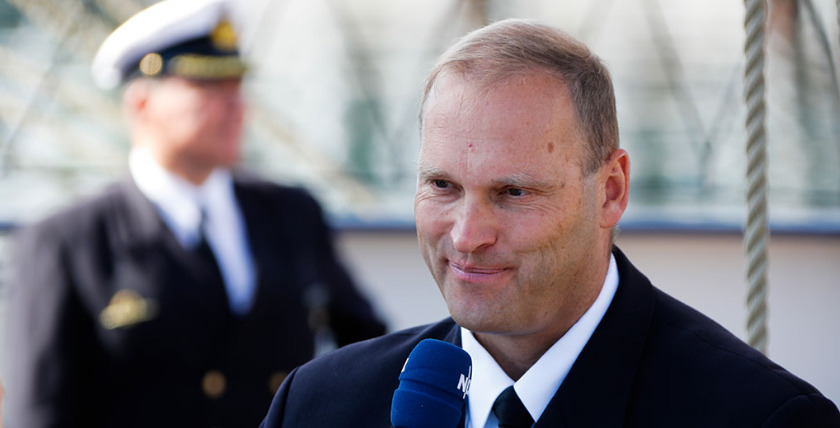
Back to the routine
The Gorch Fock made her first successful "appearance" after years of repair drama during Kiel Week. The last time the German sail training ship had led the Kieler Woche windjammer parade was seven years ago. She was accompanied by 70 tall ships and traditional sailing ships, 16 motor and steam ships and a further 50 sport sailing boats. Around 130,000 spectators were able to watch this on land and from accompanying boats. Other participants included the training ships Shabab Oman II from Oman, the Dar Mlodziezy from Poland as well as the Alexander von Humboldt II, the Thor Heyerdahl and the Roald Amundsen.
After the summer break, the new commander returns to training operations. On 8 August, the ship left its home port of Kiel for its first training voyage abroad under the command of Captain Andreas-Peter Graf von Kielmansegg. She is scheduled to take part in the Hanse Sail in Rostock as well as a port call in Szczecin (Poland) and Helsinki (Finland). The Gorch Fock is expected to return to Kiel at the end of September.
Around 100 officer candidates from the 2021 crew will gain their first maritime experience on board the tall ship as part of their basic seamanship training. Here they will learn the basic seamanship skills. They will experience the importance of teamwork and camaraderie in practice before moving on to the academic part of their training at the Bundeswehr universities in Hamburg and Munich.
Text: Holger Schlüter, Editor-in-Chief marineforum
14.08.2022 - Gorch Fock at the Hanse Sail in Rostock
81 metres long, 23 sails, three masts up to 45 metres high - the Gorch Fock is not only one of the most famous sailing ships in the world, but probably also the most imposing. ⛵ The famous naval training ship underwent six years of refurbishment and now looks more majestic than ever. Everyday life on board is just as impressive as the three-master itself: the tall ship can only be steered with many well-coordinated hands, focussed minds, a lot of skill and a little courage. This is another reason why a training cruise on the ship is still part of basic naval training. After all, anyone who has ever sailed on the Gorch Fock and mastered many an extreme situation will leave a lasting impression - an indispensable experience for all young officer candidates ... With this in mind: Fair winds!
Text: Kirsten Düspohl
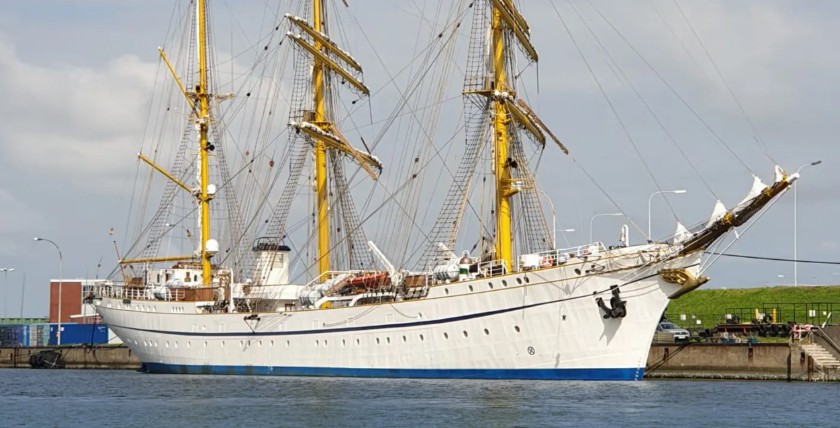
30.09.2021 - A column on World Maritime Day
When German Navy units carry out repairs, there are predefined procedures and detailed plans. This often leads to delays and breakdowns, and sometimes things go wrong during functional checks. Some things are annoying, others a trifle. In the end, the shipyard returns the unit to the navy via the Federal Office of Bundeswehr Equipment, Information Technology and In-Service Support and the naval arsenal. This is followed by the restoration of operational capability. And in a few years, the cycle begins again. That is naval life.
There is actually no need to report on this, unless we are talking about the Gorch Fock. Her restoration is something special, because the sail training ship only exists once and has different functional conditions than a warship built in more or less large numbers. In addition, the prehistory is too long, too exciting and too agonising. Every normal movement of the ship with tug assistance is therefore commented on as if something would break again every second. The sea cooling water valve, for example: the defective part should be put in a museum, as it is probably the most frequently mentioned standard component of a ship in the history of the German navy.
There is never a news report that does not reel off the shipyard scandal, the ever-increasing millions and the delays over the years like a mantra. And every now and then there is a random interviewee, like this morning on NDR. A picture of former Defence Minister Ursula von der Leyen was missing this time. Those who are given some space by their editors mention the fatal accidents that occurred over ten years ago. And experts regularly appear to talk about new buildings or tropical timber. For example, the engineering firm Löll, which takes the liberty of publicly belittling its well-paying client, the German Armed Forces, on ntv. Business partners don't deal with each other like this, but for a minute and thirty minutes of fame on scandal-ready breakfast television, you can indignantly rehash everything that is well known.
The Norddeutscher Rundfunk presenter asked today whether the "breakdown story is slowly coming to an end". Yes, it is coming to an end. Now. Today marks the beginning of the future for the ship and crew. Men and women who have had to endure this ordeal for years, but who are not responsible for the cost explosion, delays and fraud. The "ship of fools", as Der Spiegel once wrote, is the responsibility of others. The difficult years will haunt the ship in the long term, not only because of its opponents, but also because of the mockers who find personal satisfaction in badmouthing it. The self-sacrificing crew, above all the commander Nils Brandt, need our trust now. They do not deserve malice. As of today, the scandalous story is what it is: history.
And on Monday, the Gorch Fock will return to her home port of Kiel. Before that, Defence Minister Annegret Kramp-Karrenbauer will board the ship at sea together with the Inspector of the Navy, Vice Admiral Kay-Achim Schönbach. When the sailing ship arrives, salutes will be fired and the ship will sail past the State House. Finally, the barque will be back home at around 3.30 pm. Let's hope for the best. We will report back.
Gorch Fock in Wilhelmshaven's North Harbour at the beginning of September Photo: Mergener
Text: Holger Schlüter, Editor-in-Chief marineforum

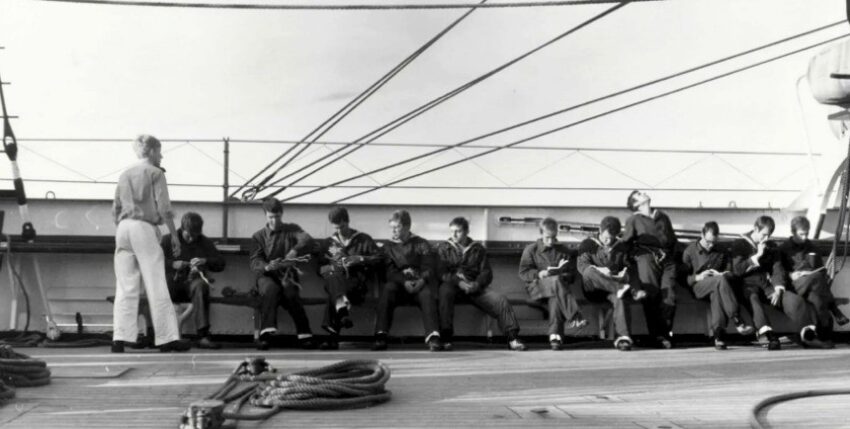






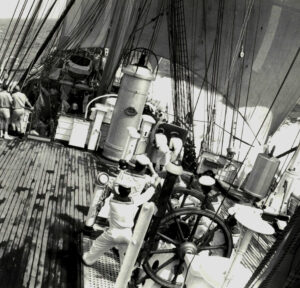
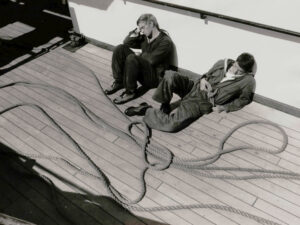
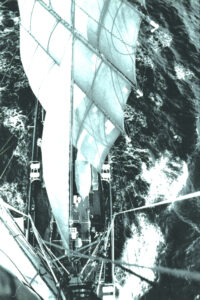
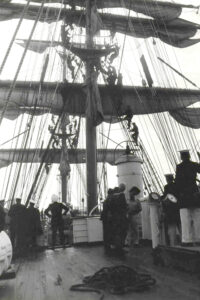
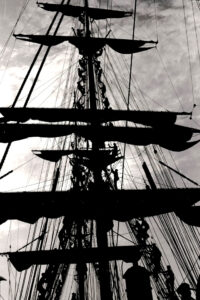
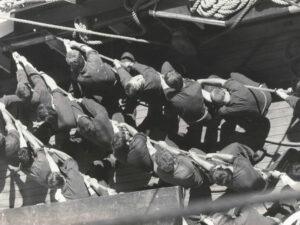
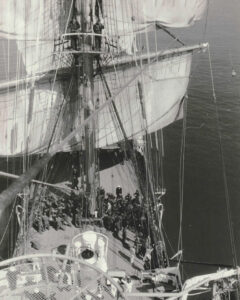
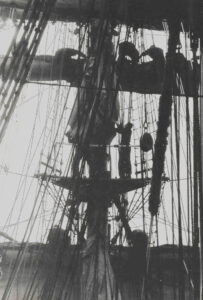
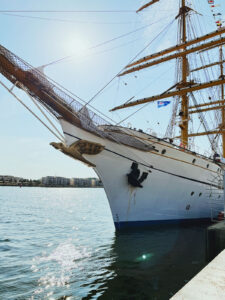
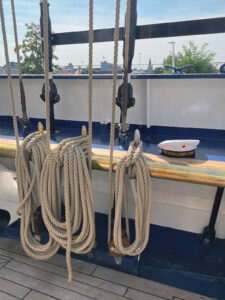
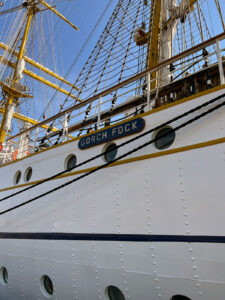
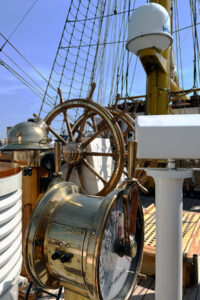
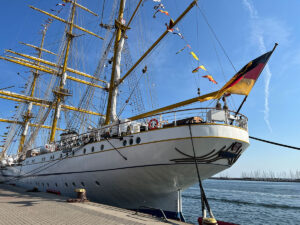
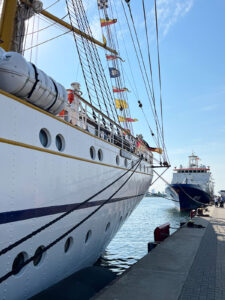
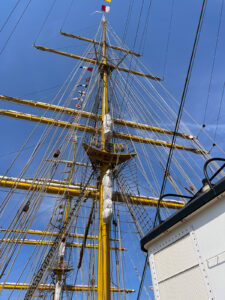
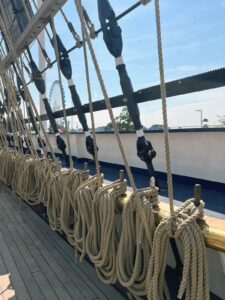
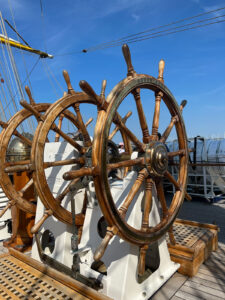
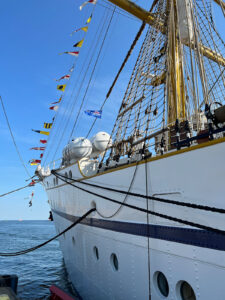



5 responses
Mr Schlüter,
Thank you also for your clear words. Indeed, Mr KptzS Brandt deserves every recognition and support for what he has achieved together with his crew. All the less do I understand once again the press work of the navy. In this context, I refer to the article in the Saturday edition of the Kieler Nachrichten and the accompanying commentary (print edition) and online: URL: https://www.kn-online.de/Kiel/Segelschulschiff-Gorch-Fock-erstmals-wieder-auf-See [16.10.2021].
Have we learnt nothing from the past? A lack of openness and transparency only leads to speculation. I am not unfamiliar with the term 'remaining work' after a shipyard laytime, but is this really so extensive in the case of the "Gorch Fock" that it should not be publicised? We should be more honest and open with the press, both on-record and even more so off-record. It is in no way comprehensible why we didn't go on board with the press representatives. In my opinion, the door has once again been opened to all kinds of speculation (see Behling: Taxpayers must stay outside. KN 16.10.2021, p. 16).
Seafaring is and does "h": Solidary greetings from us on holiday in the "East", also from our comrades in the Polish naval fleet: 3rd Flotilla "Kommodore Bolesław Romanowski" (3rd Flotylla Okrętów im. kmdr Bolesława Romanowskiego), naval base Gdynia
Also from me: THANK YOU for these important words in the column; may they find nationwide attention and dissemination.
In this context, the commentary by VAdm C. Stawitzki on LinkedIn is worth reading
https://www.linkedin.com/feed/update/urn:li:activity:6849386694727254016/?commentUrn=urn%3Ali%3Acomment%3A(activity%3A6849386694727254016%2C6849424947605991424)
and my answer, even if it was given with a great deal of emotion. What I stand by.
And, Mr Editor-in-Chief, with all due respect: the negative comments of others (not the attention-seekers or SDS sufferers quoted above) have their value where they put their finger on the malaise pus of our armaments and repair planning. But unfortunately they do not go deep enough to actually contribute to healing.
Well then. Seafaring is necessary. In our navy WITH "Gorch Fock".
Thank you for the clear words!
We wish the commander and the crew of the Gorch Fock a safe journey at all times!